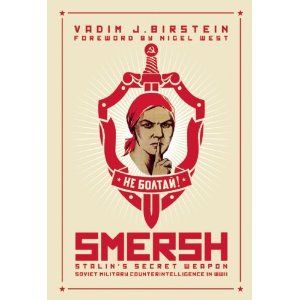Smersh: Stalin’s Secret Weapon – Vadim Birstein documents an untold part of Stalin’s horrors
 Thanks to Ian Fleming and James Bond, SMERSH is one of the best known foreign intelligence agencies in the world, with its chilling acronym based on the Russian for ‘Death to Spies’. However, as this book starts out explaining, much of Fleming’s version of SMERSH is wrong. Not only has little accurate information been published about SMERSH, even less has appeared in English.
Thanks to Ian Fleming and James Bond, SMERSH is one of the best known foreign intelligence agencies in the world, with its chilling acronym based on the Russian for ‘Death to Spies’. However, as this book starts out explaining, much of Fleming’s version of SMERSH is wrong. Not only has little accurate information been published about SMERSH, even less has appeared in English.
That makes this book, based on voluminous access to secretive Russian official records, an impressive and important piece of scholarship. It also means that the accounts in the book are often fragmentary, with the scattered evidence building up a broad picture of one of the most violent parts of Stalin’s secret state apparatus but also picking up and dropping incomplete fragments of the picture with great regularity. Moreover, the author, Vadim Birstein, has decided to document in as much detail as he can the changing bureaucratic structures of SMERSH.
This makes for a book that is heavy reading. Full of useful information for the specialist but short of excitement or drama for the casual reader. Starting with three acronyms in the foreword’s first sentence, the book follows up with a second sentence containing four acronyms and continues in that vein.
The writing style is also rather unsettling for, whilst Birstein is undoubtedly still full of righteous anger at what Stalin did to millions of innocents, the tortures, murders and disappearances are often reduced to the level of statistical organisational detail. Occasional stories insert a reminder of the humans behind the numbers, as with Stalin’s order to General Zhukov, “You should not believe in prisoners of war. You should interrogate a prisoner under torture and then shoot him to death” or this reminder of the horrors of war, from a Moscow citizen:
I saw children sliding down a hill … After I approached them, I realised that they were using [as a sled] the frozen body of a Fritz [i.e. German soldier]. His boots had been removed and his feet were cut off. Water was poured over the body, and it was covered with dung. The nose was destroyed … The kids pulled the body uphill with a hook.
But much of the time the book presents lists of numbers and details in a factual manner, written in a style that could just as well apply to a history of pig production under the Communists.
Perhaps necessarily because of the patchy evidential record, there is little analysis of why SMERSH did what it did. Certainly there were huge numbers of innocent victims, but Birstein never gives the reader much of a sense of how much of the brutality was driven by fighting actual subversion and spying, how much by a brutal approach to enforcing military discipline, how much by internal score settling and how much by out of control sociopaths. Yet there were – as the book mentions – very extensive spying efforts aimed at Stalin’s regime and it was a regime that had at least some internal opponents. At the end of a book of 500 pages I was left none the wiser as to how large, small or insignificant a proportion of those accused were actually guilty or what the motivation was for persecuting the many innocent people who were victims.
Those criticisms of the book are perhaps inevitable given that Birstein is the first person to attempt a detailed history of SMERSH and, whatever its faults, the book is an important and necessary contribution to rescuing its violent history from the forgotten corners of history. For the first such book on a highly secretive topic, it rescues an impressive amount of information.
You can buy Smersh: Stalin’s Secret Weapon by Vadim Birstein from Amazon here.
Leave a Reply